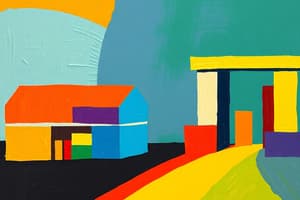Podcast
Questions and Answers
What is the main purpose of monetary policy?
What is the main purpose of monetary policy?
- To set exchange rates
- To promote globalization
- To manage money supply and interest rates (correct)
- To control poverty levels
What does trade primarily involve?
What does trade primarily involve?
- The establishment of currency values
- The distribution of wealth within a country
- The transfer of capital between countries
- The exchange of goods and services across borders (correct)
What does the term 'exchange rates' refer to?
What does the term 'exchange rates' refer to?
- The cost of borrowing money
- The interest rates set by central banks
- The value of one currency in relation to another (correct)
- The prices of exported goods
Which of the following best describes globalization?
Which of the following best describes globalization?
What is meant by 'recession'?
What is meant by 'recession'?
What does scarcity in economics refer to?
What does scarcity in economics refer to?
Which market structure is characterized by a single seller dominating the market?
Which market structure is characterized by a single seller dominating the market?
What is the focus of macroeconomics?
What is the focus of macroeconomics?
What does the unemployment rate measure?
What does the unemployment rate measure?
Which economic theory advocates for government intervention to manage demand and prevent recessions?
Which economic theory advocates for government intervention to manage demand and prevent recessions?
What defines a mixed economy?
What defines a mixed economy?
Which of the following is NOT considered a key economic indicator?
Which of the following is NOT considered a key economic indicator?
What does fiscal policy primarily involve?
What does fiscal policy primarily involve?
Flashcards are hidden until you start studying
Study Notes
Economic Concepts
- Definition: The study of how societies use scarce resources to produce valuable commodities and distribute them among different people.
Key Components
-
Scarcity:
- Limited availability of resources compared to unlimited wants.
-
Supply and Demand:
- Supply: The total amount of a good or service available for purchase.
- Demand: The total amount of a good or service that consumers are willing and able to purchase at various prices.
- The interaction between supply and demand determines market prices.
-
Market Structure:
- Perfect Competition: Many buyers and sellers with identical products.
- Monopoly: A single seller dominates the market.
- Oligopoly: A few firms control the majority of the market.
- Monopolistic Competition: Many firms sell products that are similar but not identical.
Economic Systems
- Traditional Economy: Based on customs and traditions.
- Command Economy: Central government makes all economic decisions.
- Market Economy: Decisions made by individuals and businesses based on supply and demand.
- Mixed Economy: Combines elements of both market and command economies.
Macroeconomics vs. Microeconomics
-
Macroeconomics:
- Study of the economy as a whole.
- Focuses on aggregate indicators such as GDP, unemployment rates, and inflation.
-
Microeconomics:
- Study of individual consumers and firms.
- Analyzes market mechanisms that establish relative prices among goods and services.
Economic Indicators
-
Gross Domestic Product (GDP):
- Total value of all goods and services produced within a country.
-
Unemployment Rate:
- Percentage of the labor force that is jobless and actively looking for work.
-
Inflation Rate:
- Rate at which the general level of prices for goods and services is rising.
-
Balance of Trade:
- Difference between a country's exports and imports.
Economic Theories
- Classical Economics: Emphasizes free markets and the idea that markets are self-regulating.
- Keynesian Economics: Advocates for government intervention in the economy to manage demand and prevent recessions.
- Monetarism: Focuses on the role of government in controlling the amount of money in circulation.
Fiscal and Monetary Policy
-
Fiscal Policy:
- Government spending and tax policies used to influence economic conditions.
-
Monetary Policy:
- Actions taken by a country's central bank to manage money supply and interest rates.
International Economics
- Trade: Exchange of goods and services across borders, which can lead to comparative advantages.
- Exchange Rates: Value of one currency for the purpose of conversion to another.
- Globalization: Increasing economic interdependence among countries.
Economic Challenges
- Poverty: The state of having insufficient financial resources.
- Inequality: Disparities in wealth and income distribution.
- Recession: A significant decline in economic activity across the economy lasting longer than a few months.
These notes provide a foundational understanding of economic principles and concepts, highlighting the importance of resource allocation and market dynamics.
Economic Concepts
- The study of resource allocation focuses on how societies produce and distribute valuable goods under conditions of scarcity.
Key Components
- Scarcity: Refers to the limited nature of resources, juxtaposed against unlimited human wants.
- Supply and Demand:
- Supply represents the amount of a good or service available for purchase.
- Demand refers to how much of a good or service consumers are willing and able to buy at different prices.
- Market prices are determined by the interaction of supply and demand.
- Market Structure Types:
- Perfect Competition: Many buyers and sellers with indistinguishable products.
- Monopoly: A single firm dominates the market, limiting choice.
- Oligopoly: A few firms hold a majority share of the market.
- Monopolistic Competition: Many firms sell similar but differentiated products.
Economic Systems
- Traditional Economy: Driven by customs and traditions, often relying on subsistence agriculture.
- Command Economy: The government makes all decisions regarding production and distribution of goods.
- Market Economy: Individuals and businesses make decisions based on supply and demand dynamics.
- Mixed Economy: A blend of market and command elements, incorporating both private and public sector influences.
Macroeconomics vs. Microeconomics
- Macroeconomics: Examines the economy at a national or global level, focusing on aggregate metrics like GDP, unemployment, and inflation.
- Microeconomics: Investigates the behaviors of individuals and firms within markets, determining price dynamics and resource allocation.
Economic Indicators
- Gross Domestic Product (GDP): Measures the total economic output of a country—reflects the value of all goods and services produced.
- Unemployment Rate: Indicates the percentage of the labor force that is unemployed and actively seeking work.
- Inflation Rate: Assesses the rate at which the general price level of goods and services rises, affecting purchasing power.
- Balance of Trade: Represents the difference between a country's exports and imports, indicating trade surplus or deficit.
Economic Theories
- Classical Economics: Stresses self-regulating markets and the efficiency of free-market mechanisms.
- Keynesian Economics: Suggests government intervention is necessary to modulate economic cycles and sustain demand.
- Monetarism: Concentrates on the control of money supply as a means to manage economic stability.
Fiscal and Monetary Policy
- Fiscal Policy: Entails government spending and tax strategies aimed at influencing economic performance.
- Monetary Policy: Involves the central bank's management of money supply and interest rates to regulate economic activity.
International Economics
- Trade: Refers to the cross-border exchange of goods and services, often leading to comparative advantages between nations.
- Exchange Rates: Determine the relative value of different currencies for international transactions.
- Globalization: Involves the growing economic interdependence and integration of world markets.
Economic Challenges
- Poverty: The condition of not having enough financial resources to meet basic living needs.
- Inequality: Reflects disparities in wealth distribution and income among different social groups.
- Recession: Characterized by a significant decline in economic activity, typically lasting several months or longer.
Studying That Suits You
Use AI to generate personalized quizzes and flashcards to suit your learning preferences.




